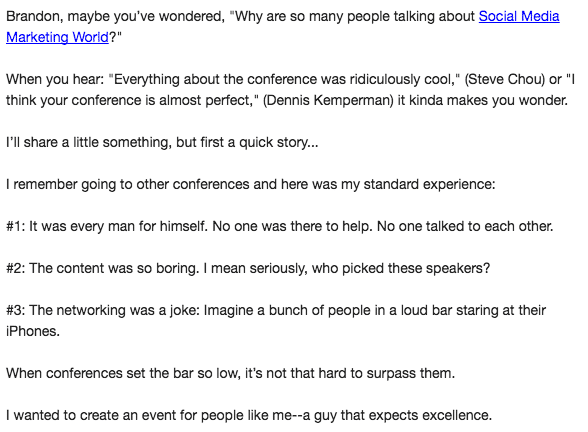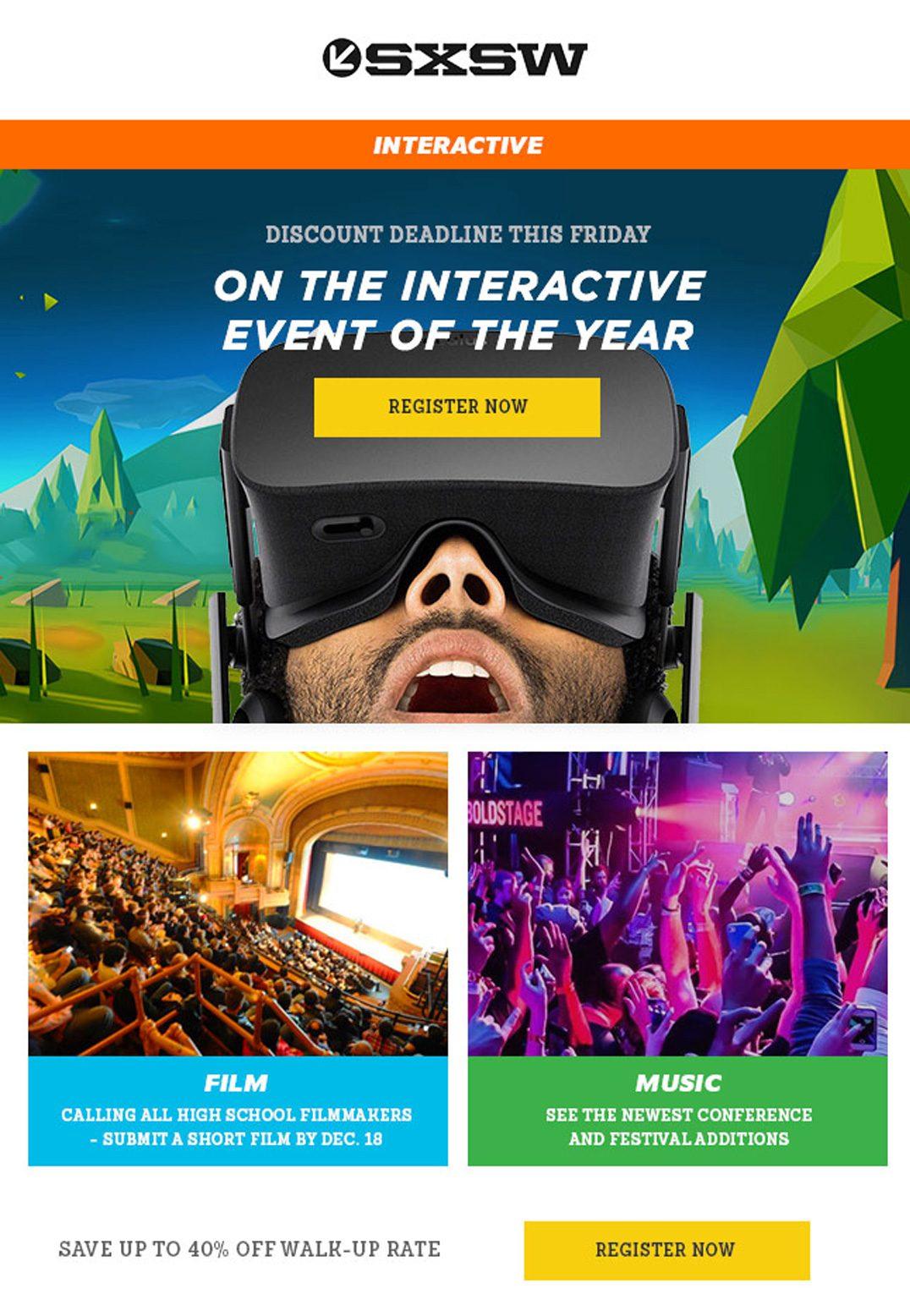Drive attendance and ROI with email marketing for events
Events are an excellent way to promote your business, attract new customers, and boost sales. And event attendance is a key factor in producing those benefits. Email marketing for your event is a critical component for success. An effective email campaign can boost registration and attendance, while also increasing your ROI.
How do you create an effective email marketing plan? With our tips, you can design a campaign that takes you all the way through your event to a profitable end.
10 ways to use email marketing to boost registration
The first goal of email marketing for events is to bring in registrations or ticket sales. We have 10 tips to help you create the emails that will stimulate enough interest to get your audience to sign up.
1. Target your audience and make it personal
It is much more efficient to send 100 emails to an audience that already has an interest in your event than to send it to 500 recipients with no interest. Segment your audience by factors that relate to your event, such as age, location, job title, or industry.
Once you have identified your audience segment, personalize each email to increase your open rates. Email subject lines that include the recipient’s name are 26% more likely to be opened. Here is an example of a personalized email from Social Media Marketing World:
Source: Campaign Monitor
Targeting and personalizing emails increase open and click-through rates, while minimizing the chance your email will be labeled as spam by your recipient.
2. Make emails mobile-friendly
As many as 96% of Americans own a smartphone today, according to Pew Research. About half own a tablet device. Since your event invite is likely to be viewed on a mobile device, your message must be mobile-friendly. Emma features templates that can be adapted to fit any screen size, ensuring recipients will receive the highest quality message from you.
3. Focus on the benefits
People will be more motivated to attend your event if they know what’s in it for them. In many cases, people attend conferences and other happenings because they have a problem and they are looking for a solution. If you identify your solution right away, you can grab your reader’s attention and increase the odds they will act on your message.
Other times, people become interested in an event because they stand to gain something of value, such as the chance to try out a product before it hits the market. Let your audience know what they stand to gain from attending your event early in the message.
4. Reward early birds
You can create a sense of urgency with your invite by offering a special promotion with a deadline. The early bird discount is a common way to motivate your reader to act quickly. Nearly two-thirds of event planners consider early bird discounts to be the most effective way to promote an event, according to BizBash and Eventbrite.
The key to using this tactic successfully is to set a hard deadline for the discounted pricing. Second, create a compelling call to action to drive your customers to act quickly. You can also send follow-up emails that show how fast tickets are selling by giving counts on how many tickets are still left.
5. Offer social proof
Robert Cialdini, psychology professor and author of the book, Influence: The Psychology of Persuasion, lists consensus or social proof as one of his six primary principles of persuasion. Cialdini explains on his website, when determining their own behaviors, Especially when they are uncertain, individuals will look to the behaviors and actions of others people will look to the actions and behaviors of others to determine their own.” You can leverage social proof in your email marketing for events.
For example, you might show photos or videos from last year’s conference that demonstrate the event was well-attended. You can also include a testimonial from a previous attendee that lists the benefits they received. If you had media coverage of a previous event, you can include that information as well. By labeling this happening, “the interactive event of the year,” the email below conveys that this is something gamers will not want to miss.
Source: Campaign Monitor
6. Add compelling images or video
Marketers only have about 10 seconds to grab the attention of their audience, according to Sociable. Written content may not be the best way to use those 10 seconds. Instead, consider incorporating a visual like a compelling image, GIF, or video in your email.
Include a video that showcases the highlights of your event, such as guest speakers or the product launch. If your event will be hosted at a luxurious venue, photos of the location are ideal. Displaying images or video of people enjoying your event is another way to entice new attendees or encourage previous visitors to come back.
7. Create dynamic content
Dynamic or smart content is content that changes based on the recipient of your email. For example, you might change images or information based on your subscriber’s location. Dynamic content has been shown to improve click-through rates, which could increase your registrations or ticket sales.
Here are three ways you can incorporate dynamic content into your email marketing for events:
-
Demographics: These variables might include age, gender, race, location, marital status, and occupation.
-
Customer preferences: When you allow customers to choose their preferences for how they receive content, the content instantly becomes more relevant.
-
Email data: This information can be collected from your email data and might include your customer’s opens, views, and click-throughs.
Here is an example of an email that uses dynamic content to target a specific recipient:
Source: Campaign Monitor
8. Include all the event details
Once you have created interest in your event, make sure you include all the event details. This information should include the date and time of the event, the venue, and contact information. This email offers all the details of the event, as well as a sneak peek of what visitors can expect:
Source: Campaign Monitor
9. Include a bold CTA
The final component to your email should be a bold call to action with a prominent RSVP button for easy response. While this is an essential part of any email marketing campaign, it becomes even more critical when the email is an event invite. When your customer presses that button, it provides the sense that they are committed to your event. Capturing this information also allows you to send reminders about the event to boost your attendance.
10. Test it out
A/B testing is an essential component to any email marketing for events, as this step ensures the best performing emails go out to your target market. A/B testing involves the creation of two slightly different emails that are sent to a small group of contacts. From this step, you can determine which email performs better before sending it out to your full list. You can test a variety of features with this process, including your subject line, layout, headlines, and content tone.
Once you get your email sent, tracking results allows you to tweak and modify campaigns along the way. Email automation that includes tracking tools is the easiest way to track registrations, ticket sales, and attendance accurately.
Emma has introduced an upgraded integration with Eventbrite that makes tracking easy for Emma users. This integration tool is one of the most effective ways to drive ticket sales, engage with customers and track revenue.
Email plan to boost attendance
While your initial email is typically designed to get registrations or ticket sales, you also want to be sure your event is well attended. This is where a series of emails can be very useful. Consider an email schedule that looks something like this:
-
Initial invite: In this message, you introduce your event and invite your contacts. You can also ask them to share the invite if you like to increase your exposure.
-
Confirmation of RSVP: If a contact does RSVP from your initial invite, it is beneficial to send a confirmation right away to ensure your contact’s spot. You can also use this message to provide additional information about the event so they can get ready for it.
-
Reminder invite: This second message goes to your contacts that didn’t respond to your initial invite. Include new information to entice these recipients to respond this time around.
-
Event reminder: This message targets those that sent their RSVPs, to remind them about the upcoming event. Depending on how far out your invitations were sent, you might want to include more than one event reminder to keep the date fresh in your guest’s mind. Reminders are essential for ensuring your attendance is as high as your registrations.
-
Thank you: After the event, send a message thanking your guest for attending. You can also use this opportunity to ask for feedback that might help you improve the event in the future.
This schedule works best with an automated email sequence that sends your targeted emails at a designated time. The system can also filter out those that have already responded to ensure all your recipients receive the appropriate follow-up messages.
Email marketing for events and ROI
Event ROI refers to the amount of value an event produces minus the amount that goes into producing the event. Value may include more than simple revenue. If the event was used to generate leads or establish networks, the ROI can factor in those results as well.
When it comes to measuring the ROI of your email marketing efforts, you want to look at:
-
Open rates
-
Click-through rates
-
Unsubscribe rates
Additional KPIs for event marketing might include:
-
Number of registrations
-
Number of attendees
-
Social media exposure
-
Exposure on other online media
-
Visits to the website after the event
By carefully measuring these KPIs after your event, you can determine whether it was successful and what you might do differently next time around to increase your ROI further.
Wrap Up
Email marketing for events is an effective way to target your audience with personalized messages that increase both your registrations and your attendance at the event. Successful marketing involves:
-
Crafting attention-getting emails using a variety of marketing techniques
-
Testing messages before they are sent to your full contact list
-
Tracking results so you can know what is working and change what is not
-
Scheduling a series of emails to ensure the greatest number of responses
Not seeing the results you want from your email marketing for events? Check out these tips on mistakes you might be making to lower your conversion rates.
MOST RECENT ARTICLES
Want to engage your audience and grow your brand? Try Emma's robust easy-to-use product today.

















